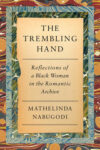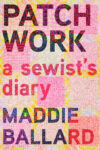This essay was first published last month in our subscriber-only newsletter. To receive the monthly newsletter and to support Full Stop’s original literary criticism, please consider joining us on Patreon.

Go back, if you can: read this like it was the first time you were on the internet and knew about it. If you’re old enough, this may take some imagining. The clang of dial-up, IRC or usenet before that; the ISP’s walled garden; typing http:// for reasons you did not completely understand—you’ve got mail. If you’re young enough, it might be easier—maybe your internet was just always like this, swift and seamless. Or maybe you don’t even remember the first time. An odd thing, though: the more familiar that memory, the higher its stakes will be. You probably work on the internet already, on Canvas, Slack, or email. And you know this internet makes millionaires and even billionaires as a matter of course, anoints some lives and ruins others, decides what you should watch and who you should date; you spend time there because it is at least as real as your material life. But a longer-ago internet mattered less: a grainy frame of porn, a gaudy hobby-obsessed angelfire site, tournament-seeding debates in fixed width fonts. A place you may have gone because it was not the world—shorn of implication or result.
A few of us, though, met the internet when we were tweens, or thereabouts—when it was half-formed, half-forming, and erratically real. AOL Instant Messenger didn’t really matter, except that it was the primary venue for flirting, the “away message” a critical piece of personal branding. MySpace was dumb and gaudy, except when an alteration to a top-five list blew up lunchtime for a week. Livejournal was where you posted misspelled emo lyrics alongside urgent cries for help. It was a strange, consubstantial time, the world still the world but wavering under the pressure of something else—another world, another discourse. There, people were themselves and not: braver and crueler, smarter and stupider. We lied about our lives in order to be honest about our desires.
And now we, the millennials, are all grown up, and the internet, too. We were kids together. And now we are not.
***
Aiden Arata and her friend Melissa, bored tweens in noughts Los Angeles, could not have been first to ship The Lord of the Rings’ Merry and Pippin. They may, however, have been among the few to realize the fiction through found forms—emailing “in the bathroom of mordor, we had passionate hobbit sex” and making AIM accounts to play out an intricate love triangle with a homewrecking Frodo. Their story opens Arata’s essay collection You Have a New Memory, which chronicles a dialectical becoming: how the internet made her a person who makes things for the internet (@aidenarata, Instagram’s smartest meme account) and how it has all felt.
Innocent enough, early on. The Mordor-bathroom sex is virginally abstracted; the relationship beats mostly betrayal-and-reconciliation loops lifted from the other ring quest they’re watching, Joe Millionaire. But when Arata meets the nebbish Brian at a friend’s bar mitzvah, things get complicated. Brian is an ahead-of-his-time reply guy, anxiously messaging every time Arata logs on to AIM, but her heart is already pledged in an optimistic crush on an older barista. So, she and Melissa present their fictional Merry screen name as an actual, precluding boyfriend.
By the time Brian develops a real crush on the invented Merry, the situation is ornate—Cold War, Le Carré at Harvard-Westlake. The enemy agent falls for the cover story in both senses, but meanwhile the covered agents have fallen for each other, kissing on dog walks. And in the end everything implodes—Melissa intuits that Merry is gay, Brian discovers that Merry is nonexistent, and the girls, haunted by their fabulations, stop talking altogether. And when Arata finally runs into the barista outside of work, optimism curdles to embarrassment: He skateboards away, looking at her “not with desire, but discomfort. Like I was the thing to be afraid of.”
Liar, Brian accuses. But the truth is more complex: for everyone involved, these lies have been ways of telling truths. As in Joe Millionaire, where women compete to marry a construction worker posing as a millionaire, the fictional discourse of desirability does not preclude but produces real desire. And in fact it is easier that way; the real life of actual bodies in actual spaces is messy, terrifying, indecisive. If you would like to be loved, everyone here knows, you must first pretend to love, to be loved, to be lovable. In the last episode, after the construction worker is revealed as penniless, the network writes the lovers a million-dollar check.
If this is not precisely the core millennial psychodrama, it is at least not far removed from the familiar account: raised in a world that was deregulating banks as energetically as it was founding Montessori schools, we became very caring strivers. Our best trait is our easy imagination of a better world; our worst, the stubborn conviction that we can achieve it by individual performance. Rightly skeptical of an economy competitively quantified by capitalism and the SAT, our major spontaneous contribution to the world has been the competitive quantification of the social itself. Of course we would want to cheat a bit at being loved. And is it really cheating if we intend, earnestly and any-day-now, to receive our million-dollar check? To become the charismatic hero depicted by our grid?
***
Amanda Hess’s Second Life, also a memoir-in-essays, considers Hess’ pregnancy and early parenthood as mediated by the internet and its devices. As in You Have a New Memory, the first encounters are at least a little cute: Hess, an incisive digital-culture critic for The New York Times, is won over by the period-tracking app Flo. She “kept Flo in my pocket…opening her felt like accessing my body in the form of an appealingly dull video game.” As she attempts to conceive, Flo’s chart of attempts and conditions makes the app itself a valued confidant, “like a dream. All my sublimated thoughts surfaced there. Desperation over my age, my fertility…in the dark closet of my phone, I slipped it on.” She tells Flo she is pregnant before she tells her husband.
Hess does have concerns. There are, first, those desperations: the internet’s familiar conjuration of inadequacy, developed through the book toward a razor-sharp anxiety-of maternal-virtue. But Hess is aware, too, of concerns about data privacy, and skeptical of Flo’s astrology-coded cycle-advice. And she knows, too, that Flo historicizes uncomfortably—that it was founded by Belarusian serial-entrepreneur brothers who “‘wanted to better understand their loved ones,’” and therefore “born from a desire to make men feel confident,” and is now worth more than a billion dollars. Period-tracking, too—among its pioneers were feminists and eugenicists, women like Marie Stopes who wanted to understand fertility in order to advance the white race and once mailed a book of romantic poems to Adolf Hitler.
Nevertheless, Hess persists, a millennial compromised-consumption that forms one of the key effects in Second Life. In each chapter, Hess relates a new phase of maternity to a new technological armature—conception is mediated by Flo, early pregnancy by targeted advertising, later trimesters by ultrasound and fetal imaging. Always Hess-the-critic notes political and systemic concerns: the surveilling, essentializing and oft-exclusionary patterns of maternity advertising, ultrasound’s utility to fetal-personhood activists and (again) eugenicists. But there too is Hess-the-member-of-society—subscribing to the Hatch emails, clicking the cutesy notifications in Flo, watching her own baby grow.
***
The best medicine and worst is other people. After Hess’s baby is diagnosed with possible Beckwith-Wiedmann syndrome, she supplements Flo’s anonymous-animal-emoji chat with every message board she can find, places where prior moms “tossed their fetuses’ symptoms into the void” but none “returned to report the outcome of their crises.” And eventually, yearning for simplicity after rounds of conflicting diagnostics, she starts consuming content from the Free Birth Society: Emilee Saldaya and other influencers who reject hospitals to give birth in yurts or under trees.
Hess doesn’t agree with the freebirthers, “debated them in my head,” but still feels compromised—influenced, even—by their charisma. “Simone had just produced a baby with the help of only a video-sharing platform,” Hess writes, “I could sense my reasoned arguments begin to crumple under the intensity of her physical achievement.” This intensity is also, Hess recognizes, a narrative achievement, a story of “birth as a mothering performance…an epic…a feat of physical and mental but also commercial control…birth story as the launch of personal brand.”
As the BWS diagnosis solidifies, Hess senses that good branding isn’t always practical advice: “pregnancies like mine did not fit into the narrative” of Free Birth virtuosity. How, without contemporary medicine, would she have known of her baby’s condition? And when her delivery requires a C-section—“presented as the dark mirror of the vaginal delivery…the ‘easy way out’”—she finds herself in real opposition to the crunchy social moms, who feel that “‘if the baby can’t survive a home labor, it is OK for it to pass peacefully.’” Hess’s fury is deadpan: “I did not think my baby should be peacefully dead.”
After her birth, too, Hess finds early parenthood complexly mediated. On the one hand are ‘smart’ devices, data-dense socks and bassinets that promise of “1 to 2 more hours of sleep” for baby and parent alike, but whose report cards deliver instead “a totemic importance…the more I doubted its efficacy, the more I invested in its promise.” Hess, yearning for less data and more community, finds herself wishing her parent friends would never leave her home, regretting how in contemporary parenthood “a sense of community was routed through consumer technologies instead.” Worn out by labor and data, she develops a brief fascination with tradwives, women who spend vaguely fetishistic hours hand-making cereal for their children. Here again the initial bloom of insecure connection gives way to isolation. “The tradwives taught me that there was a form of work I disliked more than isolated mothering: the virtual staging of isolated mothering for social media.”
***
Though Hess herself is well-platformed, Second Life is at heart a followers’ phenomenology —a chronicle of the aids and insecurities the modern internet contributes to a fundamental human experience, and the effort to hold one’s own integrity in balance with the discursive tide. When a scan finds something concerning and Hess frets guiltily about the Ativan she took during pregnancy, it’s hard not to see a rhyme with all the book’s other technologies: Hess shows ably how Second Life, like a lot of lives on the internet, is pharmakons all the way down, pills we swallow though we know they are in some way poison.
Second Life’s influencers, then, tend to be remote, self-certain, sinister, whispering heralds of a future so theatrically virtuous it might as well be post-human, people who promise forthrightly that your liberation will be heralded by your purchase of the $5,000 MLM Water Ionizer. You Have a New Memory, by contrast, is a creator’s tale—years after inventing Merry, Arata goes on to start a meme account.
@aidenarata, in its author’s words, “concerned wellness, which was to say, mental illness”— guided meditations discovering serenity in everyday objects (“you are under the mist in the produce aisle…a new you is possible…you could evaporate instead of pay your health insurance premium”); photographs overlaid by text—unusually lyric for the internet—about strong feelings (“I Want What Everyone Wants / More Love Than I Deserve”); WordArt jobs in the graphic-design-is my-passion tradition (“Pardon The Mess/Construction of My Personality Has Been Delayed/…I Lack the Serotonin to Wash My Face,” one reads, beside 90s renderings of butterfly-winged hotties fondling construction barricades). The text is often depressive or at least melancholic, but the overall effect, mixing somber thoughts with graphic codes of chintzy self-soothing, delivers a sly, joyous double negative. Perhaps I am suffering, Arata’s memes suggest, but to name the suffering precisely is a playful triumph, a rebellious lysis. “A meme can be a prompt,” she writes, one that tricks “its audience into playing with language, disrupting the relationships onto signs and simulacra.” A real relief.
Once her account starts to grow, Arata is suctioned into the business of content: invited to influencer group chats, shipped free serums and mattresses by startups who hope their product will make it into a Starter Pack graphic, brought to athleisure-brand house parties and even paid to speak at a meme conference at Meta’s New York offices. The creator communities Arata discovers are as neurotic and cross-pressured as Hess’s consumer. The whole scene’s a gift economy, Arata notes; everyone’s sharing. But a gift economy is premised on cultivating interdependence and, of course, ultimately everyone is a “middleman between the consumer and the app, and I was also the consumer, and also the product, and the other consumers were also the product, too.”
Competitive, commodified solidarity of this kind proves tense. Presence in the group chats is earned by contributing three credible brand leads a week; yoga girlies steal fistfuls of Larabars from the athleisure house and clog every toilet with so much shit the gifting suite has to be shut down; fellow meme-conference panelists steal your jokes shamelessly; the mattress-senders strike you from their lists if you don’t post swiftly or joyously enough. It’s real work selling yourself as a person who could sell to someone else, and Arata feels some similar anxieties to those parenthood provokes in Hess. She’s “struck by how strange my hands looked…my fingers had large pores. My palms were too square.” Another characteristic millennial concern: What if we’re not good enough for the job we already have?
The real crisis in YHANM, too, is in the tension between presence-as-self and presence-as-content. “Do the Right Thing,” the collection’s centerpiece, reflects on Adam, who makes “anti comedy comedy posters” and has a cat named Trader Joe and a nonexclusive, orange-flaggy “relationship that isn’t a relationship” with Arata, then a fledgling meme account dwarfed by Adam’s more substantial following. When another woman posts on insta that Adam “‘does not care about consent!!!’” a combination of personal decency and intuited status vulnerability puts Arata in the awkward position of confidant and coach for Adam’s process of reform.
It works, for a bit: Adam is good at language games. His promises are thoughtful and well-phrased; he concedes he was “‘not as perceptive as I thought’” and “doesn’t want to invalidate how she feels” and “feel[s] really bad if I made her feel that way;” he discourses ably on his conditioning by “rap music” and his need to seek therapy and cultivate presence. Soon, though, Arata realizes that Adam has raped her, too. When she messages Adam about it privately, he goes back to the language games, “talking to you like you’re his adversary in debate club. Or like he is crafting the perfect screenshot.” She realizes: “Adam lies.”
And so Arata (the situationship already over) must confront a difficult genre: the callout, defined by a very precise level of alienation, “personal, but less confessional…third-party abstraction.” This “standard of clinical detachment” precludes direct ekphrasis of the worst intensities, the body as “core of frozen poison.”And memes (Daria in the refrigerator box, “i feel like maybe the only reason it wasn’t rape is that i didn’t try that hard to say no”) are an imperfect retort: “you cannot shitpost your way through this,” Arata realizes. The callout’s “tools are a platform predicated on performance and a [legalistic] language that is historically hostile to your experience…you must be likable, sharable, marketable.”
And once Arata does post, what’s forthcoming is an onslaught as confusing as supportive— “many, many messages…overwhelmingly, shockingly kind” but also “normal misogynistic ones…the woman who…asks if you are, perhaps, missing the perspective of the abuser.” There’s also literal me, too: many other Angelenos abused by Adam who haven’t said anything public but reach out now over DM. “It’s supposed to feel validating,” Arata knows, but “instead you feel overfed: a foie gras goose…forcibly pumped with the sadness of others.” It’s an alienating experience, depressing, “in the court of public opinion you are a lone hysteric. Privately, you’re the project manager of a shared trauma endeavor.” And that shock of insufficiency returns, while scanning the faces of the messengers: “an evil thought…Prettier than me.”
There is little justice. Adam sends a debate-club text or two, keeps posting, keeps gaining followers, gestures at adding ‘cancel culture survivor’ to his personal brand. Arata quits her job, fantasizes about killing him and stealing his cat, meets a fellow-survivor IRL, worries that her “whole personality is fear and anger…a mess of weakness and self-centeredness and a childish insistence that the world should be fair.” Eventually she joins a bowling league with Kayla, another of the messengers. When the rest of the bowling league asks how Kayla and Arata met, “you make silent sideways eye contact. ‘Internet,’ Kayla says.”
***
“Totality,” Kayla might as well say: we met in this world, in this history, this moment, among the prevailing circumstances. For Arata, bowling proves an apt metaphor: “You do what you can. You twist your wrist slightly…in the wild hope that somewhere else—distanced by time, space, gravity—you’ll make an impact.” It’s the anxious comedown from the Merry empowerment: the actual body left standing at the edge of a slippery rectangle, trying to understand how it can make a difference. Of course, from so far away most of what’s possible is collision. Millennial-coded: this journey from empowerment to isolation, from plasticity to imprecision. And a journey that feels particularly central as the generation, like these two authors, moves toward middle age. Middle age is often understood in contradictory terms: between 30 and 60 (non-extensive), it is a period of serene-or-stultifying consistency, and also the period when total crisis might descend. The home-owning years; the divorcing years; the years of comforts and diagnoses. In these books Hess has two children, moves apartments; Arata meets and will marry her current husband.
Beyond that, middle age requires a definition-in-depth. It is relational: when you mostly see your children and the parents of their friends. Somatic: when your knees hurt for accumulative rather than acute reasons. Consequential: when the second cocktail costs a simple majority of the next day. Historical: the age your parents were when you began to differentiate yourself. Sequential: when there are adults younger than you and the distinction really does seem to be a difference. Teleological: when it’s hard to ignore certain kinds of decline. Aesthetic: when you are as reactionary about someone else’s culture as your parents were about yours; when you prefer films about paperwork to films about superheroes.
Common among these shapes is an intuition of middle age as a kind of eclipse: when the stolid, durable authorities of material arrangements (the knee, the bank account, the repetitively strained tendon) finally gain an upper hand over the stipulated, plastic vitalities of youth. Things that have bent may not bend back. Middle age is proving a tense encounter for millennials, who have cherished our stipulated vitalities. Through the decades of our adulthood, struggling for political primacy (often against our own parents), millennials have soothed our regular defeats with the thought that time is on our side, that history is at least at the margin ennobling, that brittle grips will falter and a better world will arrive. But by middle age there is a recognition that promises may not necessarily be kept, and some dreams will be not deferred but canceled, deported, or occupied.
Often the internet has felt at least a partial ally to millennial optimism. True, it has wounded us with images of the not-quite-real—the imagined people it has offered us, hotter and more functional than ourselves, with better hands or birth narratives. But millennials’ progressive politics, too, have been premised on imagining some things that are not quite real. The internet has shown us other socialists in town, carless neighborhoods in Paris, the win-wins of climate action or student-loan forgiveness—things we must imagine in order to fight for. It has, too, been motivating, showing us the horrors of police violence and occupation alongside inspiring moments of organization and resistance. It has offered, at times, unprecedentedly egalitarian discursive spaces, places where @yr_boyfriend_merry can dunk on billionaires, who have often proved quite stupid. It has made the struggle for a better world more vital and less lonely; its plasticities and partial truths have made a space for hope alongside the insecurity. All of which is worth some generational gratitude, considering that the relationship between millennials and the internet—by now an inextricable mutual entanglement—started as an accident. Millennials are less digital natives than digital roommates, assigned to the same double in history’s dormitory; the ones who were kids when all this got started, and who grew up alongside the internet’s metastasis into a permanent substrate of social encounter. And the digital natives have not always supported our rosier visions of history or the internet. To millennials, this has been a bad shock. The internet has also proved an astonishing tool for disinformation and agitprop, and certain people younger than us seem in some ways worse. One loud faction, sold on podcast patriarchalism and dreams of triumph in a scam economy, seem eager to trade the hope of a better world for the prospect of personal comfort in a worse one. In some ways, this impulse is a perverse reiteration of millennials’ historical optimism: the dream that, if we can only create a society of scarcity and dependence, dominion will somehow prove the lone abundant resource.
Lately these people have had an upper hand. Millennials have been wondering whether things will really get better and when. Where are those shaded avenues, those sane health-care systems, those worker-owned collectives? Where is justice? Used to wondering what a better world might look like, millennials now ask whether it will ever come, and who has waylaid it, and can we survive in the meantime? Middle-aged questions.
***
Middle-aged books, too—like Patricia Lockwood’s No One is Talking About This, perhaps the novel that best captures the frantic co-creative effect of the internet. Lockwood counterposes it against the material difficulty of a very sick baby, the narrator’s niece. The novel dramatizes a contrast between Twitter (‘the portal’) and real life along axes of weightlessness, plasticity, and escape. The real world is somber, serious and mortal, a place where hypertrophy is a problem but real love and solace can be found.
The portal, by contrast, is a paradise of escape and associativity—an inventive, plastic space, capable of curing whatever distraction and simulation can cure. Twitter, the novel suggests, is not real life. But not long after the novel’s release, Twitter was in fact real life: bought by Elon Musk and turned into a safe space for fascists. And so the novel’s internet sections—their humor, their plasticity, their destabilizing potential—feel always-already elegiac, the book’s intended balance between mourning and jouissance cast, instead, into a double mourning.
Here, too: Instagram, Arata’s ‘narcissism app’ with its chorus of alienations, has already been supplanted by a network whose continued legal operation is contingent on the personal approval of Donald Trump. And almost the entire cast of Hess’s book, from the period-and-pregnancy apps to the cream-clad mamas and medical-truther podcasters, are ripe for instrumentalization by surveillance fascism. It is not at all hard to imagine reading these books in a year or three and wishing devoutly for an internet that only hurt us in these specific ways. It is already hard to read them without feeling incredibly grateful for women as a group, who have reacted to the gendered anguishes of the internet by feeling personally fucked up rather than by trying to destroy society, as men have.
These effects have to do with what has been discussed as the enshittification of the internet: a gradual replacement of experimentation and connection with scammy rent-seeking, the marquee products no longer Google Maps but shitcoins and delusional AI. This phenomenon, too, might be named middle-aged, having to do with the rescission of optimisms and potentials in favor of cynical emphases on the material. It’s time to grow up, one imagines Andreessen Horowitz saying, time to get serious, time to make a plan. Time to extract a profit, or a patriarchy, from the space of possibility. The plan, we are learning, is to make us all poorer, stupider, and more eager to be ruled.
It is not, however, clear that it is going to work. Both Hess’s and Arata’s books end with a conscious turn away from the internet as a primary social form. After dating ‘The Right Thing’s’ well-platformed abuser and a Canadian hotwife fetishist, Arata meets MG, a man defined primarily not by his content strategy but by his relationship to matter. He doesn’t, like Adam, “self-report” as six feet tall, he simply is: “Very tall. Holding a large box,” as he arrives for their first pandemic date. The box is full of oysters; he has also brought tomato soup and grilled cheese sandwiches, and teaches Arata how to shuck. She, modeling the same hyperinferentialism that’s made the book such fun, imagines split arterials, “blood, emergency rooms…hemorhagg[ing] into his martini.” Instead the hard shell opens; they will marry; the book ends in direct address: “I believe there will be things worth saving. I’m sorry. I love you. I hope you like it here.”
Hess, hoping an in-person encounter with “a foil in my construction of myself as a mother” will “help me to close” her birth story, ends Second Life by attending a freebirther retreat, Matriarch Rising. Hess drives a Ram Warlock (“a big red dick”) to the site in the North Carolina woods, then camps beside a pregnant mango-profferer and a literal knife-wielding TERF. She sketches the conference as a Dickensian comedy of contradictions: a hopeful physical solidarity based on an online affinity group whose deepest premise is that motherhood (motherhood!!!) is something like solipsistic, a proving ground for the limitless individual virtues of the mother. “It was a confusing jumble of signals, right-wing militant meets wellness mom,” Hess writes, “… [w]asn’t it odd that the internet community styled most like a hippie commune was the most bizarrely individualistic of them all?”
Hess leaves, attracting a scornful label from the conference organizer—“‘you’re the leaver.’” Back in Brooklyn, she @s MR’s conspiracy-quack doctor-in-residence about her son’s oversized tongue until she gets a reply, one that stipulates a root in “‘self devaluation…during pregnancy did you experience a self devaluation related to one of these things? Did you need to “bite your tongue?”…You can talk to children in their sleep about conflicts…to help them release the conflict.”
Then, like Arata, she reaches for the actual, in the form of her children. “I put down my phone and opened the door to the bedroom…I could hear them. Their breaths rose and fell above the mechanical fizz of the sound machine. Their breathing was synced almost perfectly together. I stood at the threshold, listening.” Like her generation, Hess has spent a long time listening: to app admonishments, podcasts and seminars, chat rooms and subreddits. We are stuck with the machines. The solace here is not only to hear humans breathing in the dark—it is that we, however long our conditioning, can want to hear them, can want the breaths of living people to rise above the fizz of the machine.
Corley Miller‘s work has appeared in The Guardian, The New Republic, The LA Review of Books, and n+1. He teaches writing in Virginia.
This post may contain affiliate links.






